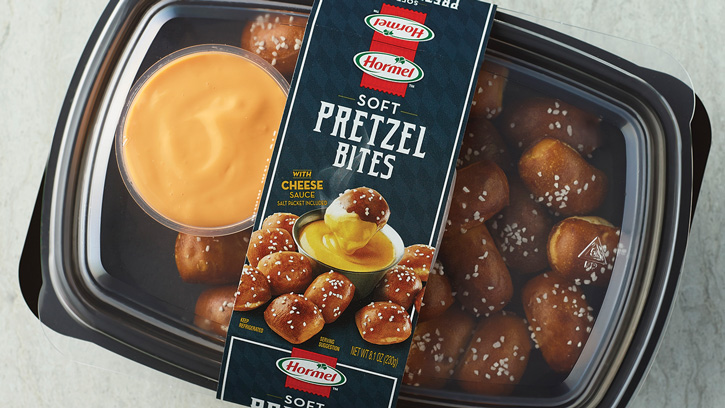What COVID Changed—and Didn’t Change—for Male Consumers
CONSUMER TRENDS
COVID-19 has driven changes in men’s food and nutrition priorities and preferences, creating unprecedented opportunities for food and beverage marketers to target this important demographic segment. Nearly half (46%) of male consumers say they are eating healthier foods since the pandemic, 45% are cooking more frequently, and 42% are exercising more regularly, according to NCSolutions’ recent Consumer Sentiment Survey.
Moreover, similar changes among men aged 13–38 will continue to solidify these new directions. Half of young men are preparing food at home more often, 49% bake, and 61% expect their newfound nutrition consciousness to continue, per YPulse’s 2021 Comfort in the Kitchen trend research.
Shopping Around
Among all regular male grocery shoppers, 29% live alone and shop for themselves, 23% share responsibility, and 47% say they do nearly all the grocery shopping for their household, although women are still more likely to be the primary household shopper, per FMI–The Food Industry Association.
Men were far less likely than women to change their food shopping channels of choice during the COVID-19 pandemic, and as of January 2021, they continue to rely primarily on the weekly shopping trip for groceries, per IRI. Men tend to spend slightly more than women on weekly grocery shopping—$125.87 on average for men versus $116.07 for women, according to the 2020 U.S. Grocery Shopper Trends report from FMI.
Men are more likely to be impulse shoppers and to decide what they are going to buy as they shop, says Lynn Dornblaser, director of innovation and insight at Mintel. Taste is the most important attribute for male shoppers when purchasing a new food or drink product. That’s followed by price, healthfulness, convenience, and simple ingredients, per IRI.
A third (33%) of male shoppers frequently look for pre-prepared, value-added fresh meat products, per FMI’s 2021 Power of Meat report. Also according to FMI, one-third of male meal preparers want to find more easy-to-make recipes in store; one-quarter would like convenient placement of items.
According to Datassential’s 2020–2021 Omnibus reports, men continue to be much more likely to dine at quick-service, fast casual, casual, midscale, and fine dining restaurants at least once a week. Still, however, as of March 5, 2021, Datassential reports that 41% of men were avoiding eating out—about the same percentage of women who were doing so. Men are more likely to order food for delivery or to go to a restaurant to order and take it out while women are more likely to use a drive-thru or to preorder via an app, per Datassential.
In the Kitchen
Six in 10 men enjoy cooking, and they’re pretty confident about their kitchen skills. Half rate themselves as a good cook versus other men, per The Hartman Group’s 2020 Diversity of American Foodways report. Men consider themselves very knowledgeable when it comes to grilling/barbecuing, preparing all cuts of fresh meat/poultry, and cooking fish/seafood, according to FMI.
Men are more likely than women to be specialty/gourmet food users (75% versus 69%), led by those aged 35–43, according to the Specialty Food Association’s 2020 State of the Specialty Food Industry report. Four in 10 men describe themselves as a “foodie,” Datassential reports.
Male meal preparers are significantly more likely than women to experiment with a diversity of preparation methods and flavors when making meals and to want to eat unique foods, per FMI. According to Mintel’s 2020 Cooking in America market report, men are more likely to cook international recipes. And men are nearly twice as likely to subscribe to a meal kit delivery service, according to FMI.
Men’s Favorites
Meat-forward global dishes (e.g., churrasco, Peking duck, and sauerbraten), which are currently trending on menus, per Datassential, have strong appeal to men. Males over-index for choosing regional cuisines (e.g., Lexington BBQ, Seattle-style hot dogs), which also are trending on menus. Twists on classics (e.g., Boston Market’s Crispy Chicken BLT Sandwich on Brioche) and limited-time offers score high with male diners, per Datassential’s January 2021 SCORES database.
Men are much more frequent dessert eaters than women, according to Technomic data. Ice cream, cookies, and doughnuts are their favorites, per Datassential. Fruit-based desserts, including cherries jubilee, banana cream pie, and panna cotta, also have high appeal to male customers.
Men have significantly higher interest in bold, spicy, smoky flavor combinations as well as charred and wood-fired preparations, per Mintel’s foodservice report. Men are most likely to try a new flavor when eating out—49% typically do so at a sit-down restaurant and 39% at a fast-food eatery, according to Mintel’s 2020 U.S. Flavor Lifecycles report. In addition, 31% typically try new flavors in a major consumer brand, 18% in a specialty food product, 15% from an online order, and 10% from a meal kit. About one in 10 men has tried adobo, tahini, and masala flavors in a chain restaurant, per Mintel. In addition, 15% have tried pesto; 12%, ghost peppers; and 6%, za’atar in a nationally branded product.
Healthy Decisions
Paying more attention to health claims and the nutrient value of food products is the top dietary change men have made since the pandemic, along with cooking more at home, per a fourth quarter 2020 trend study from HealthFocus. COVID-19 leads the list of men’s health concerns, according to HealthFocus. That’s followed by maintaining normal activities and mental sharpness with age, eye health, and memory. Men are less concerned about stress, tiredness, and appearance.
Health statistics for men are sobering: 85 million are overweight or obese, 63 million have high blood pressure, 61 million have coronary vascular disease, 42 million have cholesterol levels > 200 mg/dL, 52 million have pre-diabetes; and 19 million have diabetes (either diagnosed or undiagnosed), according to American Heart Association statistics.
Weight management, satiety, improved digestion, energy, heart health/cholesterol levels, and overall performance are the benefits men most seek from functional foods, per HealthFocus. When it comes to weight loss, low carb, keto, paleo, and Nutrisystem are the diets with a higher propensity for male adoption, per FMI.
Men are extremely interested in protein, followed by fiber, vitamin C, vitamin D, and whole grains, per HealthFocus. Six in 10 say it is important to eat fortified foods. They are less likely to think it is important to eat foods that are naturally rich sources of nutrients.
Male shoppers most often look for lower sugar/sodium, all natural, and no preservatives callouts on food labels, per FMI. They are much more trusting/accepting than women of the use of technology in foods, including GMOs and sweeteners, and much more interested in hemp/CBD, per HealthFocus.
Driven by those under age 45, males are more likely than women to eat plant-based meat, poultry, or seafood (26% versus 21%) and to opt for dairy alternatives (46% versus 43%), according to Packaged Facts’ 2020 Meat, Poultry and Seafood report.





